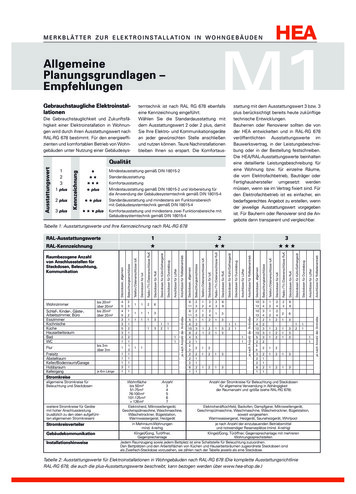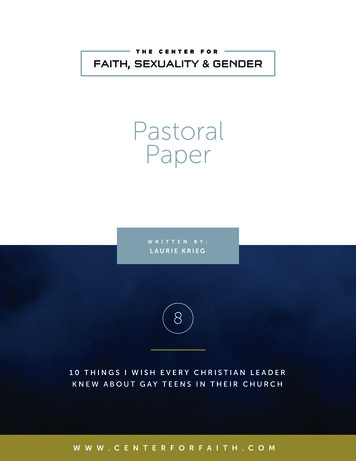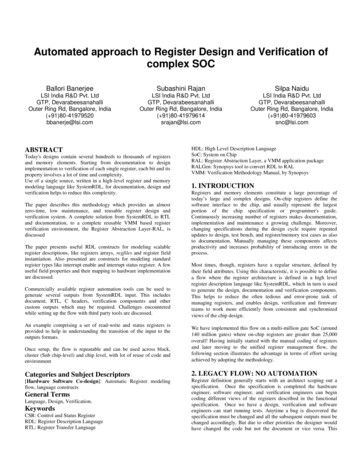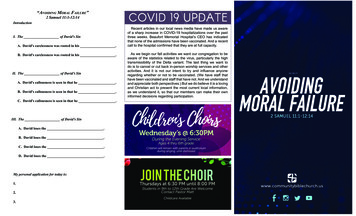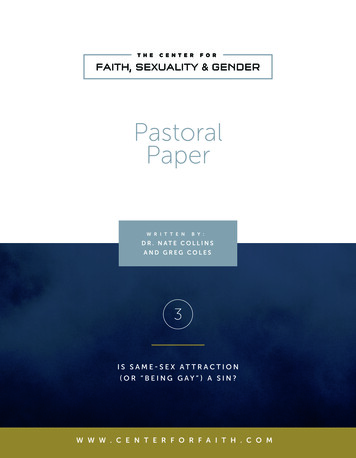
Transcription
PastoralPaperW R I T T E NB Y :DR. NATE COLLINSAND GREG COLES3IS SAME-SEX AT TRACTION(OR “BEING GAY”) A SIN?W W W . C E N T E R F O R F A I T H . C O M
T H EC E N T E RTA B L EO FIntroductionF O RFA I T H,S E XUA L I T Y&G E N D E RCO N T E N T SPG. 1What is Same-Sex Orientation?PGS. 2-3What Romans 1 Says (and Doesn’t Say) about Same-Sex OrientationPGS. 4-6Understanding Claims about the Sinfulness of Same-Sex OrientationPGS. 7-8Pastoral ImplicationNotesPGS. 9-10PGS. 11-12About the AuthorsPG. 13
PA S TO R A LPA P ER3IntroductionIs being gay a sin? We argue that the answer tothis question is “no.” Simply being gay in sexualorientation is no more or less sinful than beingstraight.1 Our attractions and orientations don’tmake us sinful or holy—it’s what we do with ourattractions and orientations, the way we stewardour sexuality, that counts in the eyes of God.Notice that we’re not saying same-sex sexualbehavior is permissible. We continue to affirm thetraditional Christian sexual ethic that reserves sexfor marriage between a man and a woman. Infact, we will assume the traditional Christiansexual ethic throughout this paper.2 But Christianscan’t just take the Bible’s prohibitions of same-sexsexual behavior and use those same prohibitionsto condemn same-sex attraction or orientation. Ifwe’re going to learn how to best love andencourage our brothers and sisters in Christ whoexperience attraction to the same sex, we need tostart paying attention to the critical distinctionsbetween attraction to the same sex, lust for thesame sex, sexual behavior, and sexual identity. Ifwe simply say “being gay is a sin” and move on,we risk condemning people for their unchosenorientation towards the same sex,communicating the falsehood that people mustbecome straight in order to follow Jesus.misunderstanding. This term was historicallyaligned with the Christian “ex-gay” movement,which argued vociferously that gay personsseeking to follow Jesus would experience changeover time in their sexual attractions. Because wedo not promote the “ex-gay” narrative, we willavoid the term “same-sex attraction” and insteaduse the language of “being gay” and “same-sexorientation” to identify a persistent sexual,romantic, and emotional attraction to membersof the same sex. This attraction, while it createsthe capacity for both sinful lust and sinful sexualactivity, is not in itself sinful, as we will show.A quick word about terminology before we begin.Since the word “gay” can refer either to same-sexorientation (apart from sexual activity) or tosame-sex sexual activity, many Christians preferthe term “same-sex attraction” as a way ofdistinguishing sexual inclination from sexualbehavior.3 However, the term “same-sexattraction” is also not free from the danger ofP G .1
T H EC E N T E RF O RFA I T H,S E XUA L I T Y&G E N D E RWhat is Same-Sex Orientation?Despite what some Christians assume, sexualorientation is fully distinct from sexual activity.That is, “being gay” or “being straight” doesn’tnecessarily mean that a person has had sex in themanner implied by that orientation. Althoughmost people who are gay in orientation will alsoengage in same-sex sexual expression, othersmight be gay even though they remain celibatefor life or choose to marry someone of theopposite sex. In fact, both authors of this paperare gay in the sense that we experience attractionto the same sex, and yet we don’t believe thatsame-sex sexual behavior (even in the context ofmarriage) is God’s design for sexual expression.One of us is married to an opposite-sex partner,but that doesn’t make him heterosexual—becausesexual orientation is determined not by sexualactivity, but by the nature of a person’sattractions.Not only is sexual orientation defined byattraction rather than sexual behavior, but theattractions that make up sexual orientation arenot all sexual in nature. The AmericanPsychological Association defines sexualorientation this way:Sexual orientation refers to an enduringpattern of emotional, romantic and/orsexual attractions to men, women orboth sexes. Sexual orientation also refersto a person's sense of identity based onthose attractions, related behaviors andmembership in a community of otherswho share those attractions.4P G .2By this definition, “being gay” is about far morethan the capacity to desire same-sex sexualbehavior. Same-sex orientation also includesemotional and romantic desires which are not atall sexual in nature. For instance, the desire tohave a deep heart-to-heart conversation withsomeone and the desire to watch a romanticsunset together might both be motivated bysexual orientation, but wanting these activities isnot the same as wanting sex, just like engaging inthese activities is not the same as engaging in sex.(If having heart-to-hearts and watching sunsetswere the same as having sex, I suspect we’d allhave a lot of repenting to do.)Of course, sexual attraction is one of the keycomponents in how we experience ourorientation. But even sexual attraction isn’t alwayseasy to understand. Sometimes our bodiesrespond in sexual ways to both sexual andnonsexual—and even non-intimate—stimuli. Inthese situations, it’s important to keep in mindthat sexual arousal is not the same as sexualattraction.5 Furthermore, sexual attraction canexist without being accompanied by feelings ofarousal. A man might be conscious of the sexualattractiveness of his wife, for example, withoutalso experiencing arousal. Or a woman whohopes to someday marry a man might begenerally aware of her attraction to men, eventhough there are no men currently in her life withwhom she wants to pursue marriage and sex.Sexual attraction, at its most basic level, is whatpeople feel towards someone with whom theymight potentially experience a desire for somekind of sexual intimacy. Sexual attraction creates
PA S TO R A LPA P ER3P G .3the capacity for lust and sex, but it doesn’t makeyou guilty of lust or sex, any more than “being adog person” makes you guilty of going to thepound and picking out a German Shepherd.Thus, our modern category of sexual orientationis simply not equipped to describe sexualimmorality or sexual purity. A heterosexualwoman is, by definition, capable of desiring menshe isn’t married to, but this capacity isn’t itselfsinful. There are ways of stewarding herorientation that will honor God, and other waysof stewarding her orientation that will dishonorGod. Likewise, a gay man capable of desiring menhe isn’t (and cannot biblically be) married to isn’tcommitting sin by his mere existence. It is nothaving a same-sex orientation that the Bibleforbids, but acting on that same-sex orientationthrough lust or sexual activity.
T H EC E N T E RF O RFA I T H,S E XUA L I T Y&G E N D E RWhat Romans 1 Says (and Doesn’t Say)about Same-Sex OrientationHow does this understanding of sexualorientation map onto what the Bible has to sayabout homosexuality? Most of the Bible passageswhich address same-sex sexuality speak onlyabout sexual behavior. Lev. 18:22 and Lev. 20:13describe a man who “lies with a man as with awoman” (ESV), saying nothing about thepredisposition that might motivate this activity.6And in 1 Cor. 6:9 and 1 Tim. 1:10, Paul appears tocoin the Greek word arsenokoitai (translated“men who practice homosexuality” in the ESV) bycombining the words arsēn (male) and koitē (bed),the same two words used in the Septuaginttranslation of Leviticus 18 and 20. Once again, it isclear that Paul has only same-sex sexual behaviorin view; same-sex lust is not addressed, let alonesame-sex attraction as such. Thus, these passagescertainly cannot be invoked as proof thatsame-sex orientation is sinful.The only Bible passage that speaks directly ofsame-sex lust appears in Rom. 1:26-27:For this reason God gave them up todishonorable passions. For their womenexchanged natural relations for thosethat are contrary to nature; and the menlikewise gave up natural relations withwomen and were consumed withpassion for one another, mencommitting shameless acts with menand receiving in themselves the duepenalty for their error. (ESV)P G .4Paul’s condemnation of same-sex lust (what heeuphemistically refers to as “dishonorablepassions”) should be unsurprising both to his firstcentury readers and to us. Whenever a specificsexual relationship is forbidden in Scripture,lusting after that sexual relationship is likewiseforbidden, because lust is an incipient form ofsexual gratification. This is why Jesus tells hislisteners in Matt. 5:28 that “everyone who looks ata woman with lustful intent has alreadycommitted adultery with her in his heart” (ESV).Setting our hearts towards sinful behavior is itselfa sin that is comparable in kind, if not in degree,to acting out that behavior physically.Here is where the confusion often occurs.Because Paul condemns same-sex lust in thispassage, some Christians have understoodRomans 1 to mean that same-sexorientation—that is, “being gay”—is likewisecondemned. They assume that “dishonorablepassions” must refer not only to same-sex sexualacts and lusts, but also to the capacity to desiresuch acts and to experience such forms of lust.On the basis of Romans 1, then, they declare that“being gay is a sin,” believing that same-sexorientation is a sign of rebellion against God.To use Romans 1 as a condemnation of same-sexorientation, however, is to misunderstand boththe meaning of Paul’s original Greek in theseverses and the broader context of Paul’s epistle tothe Romans. By paying careful attention to boththe text and the context of this passage, we find
PA S TO R A Lthat Paul is definitively not making a case for thesinfulness of what we now call same-sexorientation. Thus, it would be both irresponsibleand unloving to invoke Romans 1 as a way ofcondemning people who experience anunchosen orientation towards the same sex.First, let’s consider the text of Rom. 1:26-27 a bitmore carefully. In English, it’s difficult to knowwith certainty whether the phrase “dishonorablepassions” refers only to lust and sexual activity, orwhether it also includes sexual orientation. Afterall, we might reason, isn’t a sexual orientation akind of “passion”? What if Paul is using the phrase“dishonorable passion” to condemn not onlysame-sex lust but also the capacity for same-sexlust? Is “being gay” a form of dishonorablepassion that is inherently sinful?Were our discussion limited to English, our bestanswers to these questions might be mereguesswork. In Greek, fortunately, the answersbecome more apparent. The word for “passions”in Rom. 1:26 is pathos, a word which appearsonly two other times in the Greek NewTestament, both in Paul’s epistles (Col. 3:5 and 1Thess. 4:5). Although pathos has a wide range ofpossible meanings in Greek literature, Paul’sthree uses of the word all connote sexual excess.Col. 3:5 includes pathos in a list of things Paul iscalling his fellow believers to avoid, and there isnothing to suggest that it is limited to same-sexlust or desire. It seems that Paul objects to pathosof any kind, whether homosexual orheterosexual. Paul’s condemnation of pathos isstill clearer in 1 Thess. 4:5, where he uses pathosas an antonym of the kind of holy behaviorcommanded by 1 Thess. 4:4: “each of you shouldlearn to control your own body in a way that isholy and honorable” (NIV). Assuming that thePA P ER3majority of Paul’s readers in Thessalonicaexperienced primarily heterosexual temptation,the kind of pathos Paul forbids must likewise beprimarily heterosexual in nature. Whatever Paulmeans when he speaks of pathos, then, it issomething that is wrong for all people, gay andstraight alike.7Is Paul condemning heterosexual orientation inCol. 3:5 and 1 Thess. 4:5 when he condemnspathos? Certainly not. It is not the capacity forheterosexual desire that Paul calls sinful in theseverses. Rather, it is when heterosexual desire isnot disciplined—when it becomes uncontrolledheterosexual lust and sexual activity—that itbecomes sinful. All sexual desire, gay andstraight, needs to be disciplined. This is why Paulurges his readers in 1 Thess. 4:4 to learn tocontrol their bodies, rather than to seek the totalexpurgation of their sexuality. Althoughheterosexual pathos is a sin that must berepented of, heterosexual orientation remainseven in those who are submitted to Christ.Thus, Paul’s use of pathos in Romans 1 mostprobably does not refer to a sexualorientation—same-sex or otherwise. Since Paul isnot condemning opposite-sex orientation whenhe speaks of pathos in Col. 3:5 and 1 Thess. 4:5, itis unreasonable to believe that pathos mustcondemn same-sex orientation in Rom. 1:26.What Paul condemns is same-sex lust and sexualactivity, not the mere capacity for homosexualdesire.This reading also accords with the broadercontext of Paul’s epistle to the Romans. Havingdepicted in Romans 1 a form of sinfulness andrebellion against God that Paul’s readers willclearly recognize as sin, Paul flips the script andP G .5
T H EC E N T E RF O RFA I T H,S E XUA L I T Yturns the lens back onto his readers in the firstverse of chapter 2: “You, therefore, have noexcuse, you who pass judgment on someoneelse, for at whatever point you judge another,you are condemning yourself, because you whopass judgment do the same things” (NIV). Thesinfulness that Paul’s readers are so quick torecognize in others lives equally within them.If Paul’s intention is to demonstrate thesinfulness of all people—to level the playing fieldat the foot of the cross—it stands to reason thathe might point out the obvious sinfulness ofhomosexual lust in order to subsequently equatethat sin to the more insidious danger ofheterosexual lust. However, condemningsame-sex orientation as something uniquelyfallen and evil—and then congratulating thosewith a heterosexual orientation for being lessintrinsically sinful—would be completelyantithetical to the broader mission of Paul’sletter. And yet, ironically, this is precisely howmany heterosexual Christians have interpretedRomans 1. They use the passage to condemnsame-sex-oriented individuals for simply beinggay, while congratulating themselves for whatthey assume is the comparative “holiness” of aheterosexual orientation.Here’s the bottom line: Romans 1 confirms thesinfulness of gay lust. But the sinfulness of gaylust doesn’t make gay orientation sinful, in thesame way that the sinfulness of heterosexual lustdoesn’t make heterosexual orientation sinful.Both opposite-sex orientation and same-sexorientation can incline us towards certain formsof lust and sinful sexual behavior, because bothare products of the Fall. Read in light of Romans2, Romans 1 isn’t making a case for the uniquesinfulness of homosexual orientation; rather, itP G .6&G E N D E Rshows that the capacity for sin exists equally in allof us. Paul isn’t interested in whether we’re gayor straight—he’s interested in what we choose todo about it.
PA S TO R A LPA P ER3Understanding Claims about theSinfulness of Same-Sex OrientationIf Romans 1 does not condemn same-sexorientation, how is it that some Christian thinkershave still concluded that a same-sex orientationis inherently sinful? The most noteworthyapologists of this perspective are New Testamentscholar Denny Burk and biblical/noutheticcounselor Heath Lambert, who make a case forthe sinfulness of same-sex orientation in theirbook Transforming Homosexuality.8 According toBurk and Lambert, the morality of a desiredepends entirely on the object of the desire. Intheir words,If you desire something good, then thedesire itself is good. If you desiresomething evil, then the desire itself isevil (i.e., “lustful”).9As Burk and Lambert observe, the Greek word fordesire, epithymia, can communicate good ormorally neutral desire as well as sinful desire. Forinstance, Jesus’s “desire” to eat the Passover withhis disciples (Luke 22:15) and Paul’s “desire” todepart and be with Christ (Phil. 1:23) areinstances of epithymia; but, on the other hand,the “lusts” of Rom. 1:24, Eph. 2:3, and numerousother passages are also epithymia.10 An epithymiamay be admirable or sinful, depending on thetarget of the desire. Based on this linguisticanalysis, Burk and Lambert suggest thatattraction to the same sex is an epithymiatowards a sinful end, and thus it is itself a morallyculpable sin.Although intriguing in principle, this analysis failsto account for how the word epithymia is actuallyused in specific biblical texts. In all three of theNew Testament passages where epithymia is“good” (Luke 22:15, Phil. 1:23, and 1 Thess. 2:17),the “desire” being discussed is a relational,nonsexual desire.11 When the term is used ofsexual desire, it is always negative—it is lust orunrestrained passion.12 If a husband were tosexually desire his wife in a righteous manner,New Testament writers would not use the termepithymia to describe his desire. Thus, we cannotsimply say that all epithymia exists on atwo-dimensional spectrum from “good” to “bad.”In the New Testament, “good” epithymia istopically different than “bad” epithymia. That is,“good” epithymia is non-sexual, and all sexualepithymia is considered “bad.”Why does this matter to our present discussion?It matters because Burk and Lambert argue thatgay epithymia is bad, whereas heterosexualepithymia can be good.13 Yet the New Testamentdepicts all sexual epithymia as bad. For example,all three of the New Testament passages that usethe word pathos (discussed above) have the wordepithymia in close proximity. In Rom. 1:24, Paulcondemns same-sex epithymia; in Col. 3:5 and 1Thess. 4:5, he condemns (primarily) opposite-sexepithymia. Whenever the New Testamentcondemns a sexual epithymia, then, it iscondemning lust, not the mere capacity for lust(gay or straight).P G .7
T H EC E N T E RF O RFA I T H,S E XUA L I T YSimply put: we can’t use the biblical notion ofepithymia to condemn same-sex orientationwhile maintaining the correctness ofopposite-sex orientation. When it comes to sex,gay or straight, epithymia is always bad.Burk and Lambert’s assertion of the sinfulness ofsame-sex orientation also relies on their claimthat sexual attraction is the sole definingcharacteristic of orientation. In their commentsabout the APA’s definition of orientation, Burkand Lambert state that “the sexual attractioncomponent is the foundation for everything elsein the definition.”14 When they address thequestion of whether a gay orientation issanctifiable, then, they do so by placing thedesire for same-sex sexual activity at theforefront of the conversation. They conclude thatboth sexual attraction and emotional/romanticattraction to the same sex (along with simplyidentifying as gay) are intrinsically sinful sincethey are rooted in an active desire for an objectthat is off-limits.Burk and Lambert’s approach here is problematicbecause it distills the multifaceted experience of“being gay” down to a mere longing for gay sex.Yet orientation, whether straight or gay, does notnecessarily involve an active desire for sex.Consider a woman who has only ever beenattracted to men, is married to a man, and issitting at her computer planning a weekendskydiving trip while her husband tries to wheedleher into bed with him. Does she have an activelonging for sex? Apparently not, much to herhusband’s chagrin. Is she “experiencingopposite-sex attraction”? No, she’s moreattracted to the thought of jumping out of anairplane. And yet she is the textbook definition ofa straight woman. Her heterosexuality isn’tcontingent on the degree of her sexual desire atany given moment.P G .8&G E N D E ROr consider a gay man who accidentally wandersinto a room full of scantily clad women. Whereasa straight man who has made the same mistakewould likely be sexually aroused by hissurroundings, this man is incapable of feelingsexual desire for these women even if he wantedto. In this case, it is actually the absence of asexual desire for women, rather than thepresence of a desire for men, that marks him asgay. Sexual orientation might be said to be asmuch about the things we don’t desire as it isabout the things we do desire. And this man’ssame-sex orientation turns out to be anadvantage in this case, at least as far as resistingsexual temptation is concerned.Having a sexual orientation doesn’t mean thatyou’re always in the throes of lust. It means that,when you have a sexual desire, that desire will beoriented in a certain direction. To condemn thewhole of same-sex orientation simply because itincludes the possibility of temptation towardssame-sex sexual activity is as reductive ascondemning electricity because it comes with arisk of electrocution.
PA S TO R A LPA P ER3Pastoral ImplicationsThe question of whether “being gay” is a sin isnot simply an abstract thought experiment. Onthe contrary, getting this question right has vitalimplications for the ways we engage in ministryaround issues of sexuality and sexual identity inthe church. By coming to understand thatsame-sex orientation is not itself sinful, and bybanishing the phrase “being gay is a sin” from ourChristian vocabulary, we will be far betterequipped to guide those both within and beyondthe walls of our churches into deeperrelationship with Jesus. Here are five pastoralimplications of this conversation.First, recognizing that same-sex orientation is nota sin will free sexual minorities within ourcongregations from the burden of unnecessaryguilt and shame. Same-sex oriented Christianshave often been told that they are in sin merelyfor being gay—even if they remain sexually pure.This false accusation weighs people down withan unbearably heavy load, demanding that theycannot truly experience the love of God unlessthey also experience a change in sexualorientation. By recognizing that no orientation ismore or less inherently sinful than another, webecome equipped to truly preach the gospel tosexual minorities—a gospel in which all areequally invited on the dangerous journey ofself-denial and obedience to Christ.Second, once we acknowledge that “being gay” isnot inherently sinful, we can begin to imaginewhat lives of faithful obedience might look likefor same-sex oriented Christians. For many years,the only narrative offered to such Christians wasthe reparative therapy narrative: become straightor live in sin. When the vast majority of thoseenrolled in reparative therapy failed to becomestraight, they were faced with the choice ofeither abandoning the traditional theology ofsexual ethics or abandoning their faithaltogether. If, however, “being gay” is not itself asin, then a third way must be possible: a path ofrepentance, holiness, and wholeness in Christmust also exist for those who remain same-sexoriented and continue to hold a traditional sexualethic. It is possible to repent of the sinfulbyproducts of same-sex orientation (that is, lustand sexual behavior) and to journey into deeperintimacy with Christ without also “repenting” ofsame-sex orientation and becoming straight.Third, abandoning false narratives about whatconstitutes sin equips people to better recognizeand resist things that are actually sinful. If asame-sex-oriented woman is told that hercapacity for same-sex lust is already sinful, shemay be more likely to give in to lustful thoughtsor to sexual activity because she feels she hasalready “sinned” by merely noticing herorientation. Instead of condemning this womanfor her orientation, wise pastoral leaders woulddo better to invite her to steward her sexualdesires in a way that honors God. Her pursuit ofsexual holiness will undoubtedly be difficultenough without the additional discouragementof being told that she is always and already guiltyof unrepentant sin.Fourth, by correcting the false belief thatsame-sex orientation is sinful, we become able toaddress and challenge the sins of pride andhomophobia among heterosexual Christians.P G .9
T H EC E N T E RF O RFA I T H,S E XUA L I T YMany Christians need to be reminded of Paul’smessage in Rom. 2:1 that those who passjudgment, those who feel morally superior, are infact equally a product of sinful humanity. Thepeople most obsessed with the “sinfulness” ofgay orientation are those who most need to bereminded that their straight orientation alsocomes with a unique capacity for sinfulness. IfChristians can stop insisting that “being gay is asin,” perhaps we can finally begin working againstanti-gay bigotry, bullying, and homophobiainstead of silently acquiescing to them or fuelingtheir fires.Finally, once we recognize that being gay is not asin, we will be far better situated to engage inmissional conversations with sexual minoritiesoutside the church. Most same-sex-orientedindividuals are rightly cautious of Christians whoview them as uniquely deficient reprobates orwho promise that following Jesus will make themstraight. As long as Christians persist in theassertion that “being gay is a sin,” far too manysexual minorities will hear the message that theirorientation places them outside the reach ofGod’s grace—that they cannot follow Jesus aslong as they don’t experience attraction to theopposite sex. But the gospel has never beenabout orientation change. The gospel neverranks anyone as more or less worthy of grace.The gospel is a messy and democratizinginvitation to follow Jesus, no matter what desireswe must learn to steward along the way, nomatter how costly the journey turns out to be.P G .1 0&G E N D E R
PA S TO R A LPA P ER3Notes1. We are not trying to suggest that sexual orientation is onlydon’t distinguish between sexual arousal and sexuala binary opposition between “gay” and “straight”; mostattraction, it is easy for some victims to draw the conclusionscholars, from Alfred Kinsey to Lisa Diamond, agree that thethat they somehow deserved their abuse, or that they arereality is far more complex. However, we will make oursomehow at fault for it because they experienced some leveltheological case using the categories of exclusive same-sexof arousal.orientation (“gay”) and exclusive opposite- sex orientation(“straight”) because we believe these categories can6. Of course, same-sex orientation is not the only reason ailluminate the current discussion about whether it is possibleperson might choose to engage in same-sex sexualfor any orientation to be inherently sinful. Also, we will usebehavior. For example, powerful (and presumably“gay” in its gender-inclusive sense to include the same-sexheterosexual) men have historically used same-sex rape as aorientation of both men and women.means of asserting dominance over weaker men. Accordingto Leviticus, someone who engages in same-sex sexual2. For an extensive apology of the traditional Christianbehavior stands condemned regardless of whether thatsexual ethic, see Preston Sprinkle’s book People To Beperson has a same-sex orientation or an opposite-sexLoved: Why Homosexuality Is Not Just an Issue (Grandorientation. Conversely, and most importantly for ourRapids: Zondervan, 2015), as well as other pastoral paperspurposes, someone who abstains from same-sex sexualpublished by The Center for Faith, Sexuality & Gender.expression is not condemned by these verses, regardless ofwhether that person has a same-sex orientation or an3. Some people also prefer the label “same-sex attracted” toopposite-sex orientation.“gay” because of they believe that “gay” asserts aproblematic sexual identity and that Christians ought to7. In Rom. 1:26, of course, Paul modifies pathos with theavoid such identity categories for themselves. The debateadjective atimia (“dishonorable”), probably to emphasize theabout identity and language use, although important, isfact that the same-sex pathos he depicts is regarded by hisbeyond the scope of this paper. For our purposes in thisreaders as exceptionally disgraceful. (This emphasis furtherpaper, “being gay” simply refers to the experience ofheightens the contrast of Paul’s tonal shift in Romans 2.) Butattractions towards the same sex, not necessarily to thePaul is clear that pathos does not need an adjective in orderadoption of a particular identity label.to be sinful (cf. Col. 3:5); opposite-sex pathos, like same-sexpathos, is outside of God’s intention for humanity.4. http://www.apa.org/topics/lgbt/orientation.aspx8. Denny Burk and Heath Lambert, Transforming5. Some rape victims, for example, report experiencing aHomosexuality: What the Bible Says about Sexual Orientationkind of physical arousal while being sexually assaulted.and Change (Phillipsburg, NJ: P & R Publishing, 2015).Feeling a sensation like arousal while experiencing thehorrific trauma of sexual assault produces enormous9. Burk and Lambert, 46.confusion and guilt in these situations. (See Roy J. Levin andWilly van Berlo’s study “Sexual Arousal and Orgasm in10. See discussion of the semantic range of epithymia inSubjects Who Experience Forced or Non-Consensual SexualBDAG, 372.Stimulation – A Review,” in The Journal of Forensic andLegal Medicine, vol. 11, no. 2, 2004, pp. 82-88.) When weP G .1 1
T H EC E N T E RF O RFA I T H,S E XUA L I T Y11. The two uses which BDAG regards as “neutral” (Mark 4:19and Rev. 18:14) are likewise nonsexual. The use of epithymiafor sexual desire falls only under the heading of forbidden orinordinate desires.12. See Rom. 1:24, Col. 3:5, 1 Thess. 4:5, and 2 Pet. 2:18. Inan additional seven passages (Rom. 13:4, Gal. 5:16, Gal. 5:24,Eph. 2:3, 1 Pet. 2:11, 2 Pet. 2:10, and 1 John 2:16), epithymiais paired with a form of the word sarx (“flesh”), oftentranslated “lusts of the flesh”; sexual desire is certainly inview (and negatively so) in these passages as well, though itis not the only sinful desire in view. Thus, whenever sexualdesire is even a component of epithymia, it is regarded assinful.13. This argument is rooted in their analysis of James1:13-15, a passage which depicts epithymia luring andenticing people into temptation. However, since epithymiacannot include sexual orientation (for the reasons we lay outhere), we will not discuss it at length. In short, we
nonsexual desire. 11 When the term is used of sexual desire, it is always negativeÑit is lust or unrestrained passion. 12 If a husband were to sexually desire his wife in a righteous manner, New Testament writers would not use the term epithymia to describe his desire. Thus, we cannot simply say that all epithymia exists on a

